Overview of species and varieties of daylily

Gardeners and those wishing to design their local area are invariably looking for pleasant-looking plants that do not cause any special problems. A daylily can be a good choice in this case. You just need to study it properly and use it correctly.
Peculiarities
Daylily is a perennial herb that belongs to the subfamily of daylily plants. Interesting: in our country it has an alternative traditional name - krasodnev. The homeland of daylilies is East Asia. Despite the rather long acquaintance of people with this plant, it was introduced into biological systematics only in the middle of the 18th century. Excellent decorative properties are characteristic of both cultivated and wild varieties equally.

A characteristic feature of this species is the minimum requirement for care. However, it must be borne in mind that this is true only for long-established varieties and wild plants. Many modern varieties are not yet sufficiently tested and can be a source of unpleasant surprises.
In the 21st century, new varieties of daylilies are bred mainly by Australian and American breeders. Although these varieties are more capricious than the old versions, they are much more elegant than them.
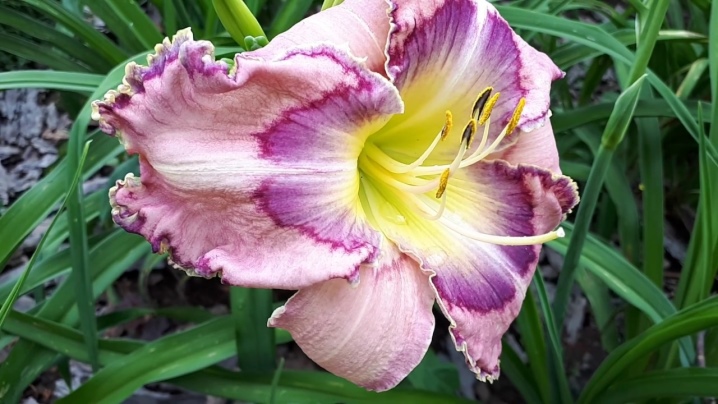
Daylily forms filamentous adventitious roots that are very thick. Their main biological role is to protect against drought. The basal plates of the leaves can develop straight or bend in an arc. The flowers are predominantly funnel-shaped. They are characterized by:
orange;
yellow;
brown-red colors.
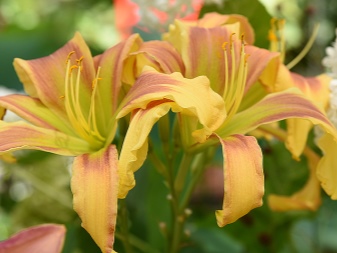

Daylily inflorescences are formed from several leaves. At the same time 1-3 flowers bloom maximum. The bush may have several peduncles covered with leaves at once. Their length depends on the variety and is 0.3-1 m, sometimes even more. Daylily fruits resemble boxes with 3 faces. In horticulture, both wild forms and specially bred varieties show themselves equally well.

The advantage of wild species is an attractive appearance combined with unpretentiousness. They are also very resistant to diseases and are less susceptible to attacks from harmful insects. These crops are drought tolerant and can live for a long time, beautifying the site.

It should be noted that daylilies (not only natural, but also improved by breeders) cannot have a pure white color. The term "almost white" is used, which can mean:
especially light melon;
lavender;
cream;
pinkish;
yellowish color.


The main directions of breeding work are now increasing the diameter of flowers, increasing their doubleness. Experts also make sure that the petals are corrugated as much as possible. They note that it is easy to work with the daylily, and new beautiful varieties can be expected in the coming years. In nature, the daylily grows at the edges of the forest, where it settles in the shade of bushes. But one must understand that in such conditions the plant feels good only in hot countries, in extreme cases - in the Mediterranean region.

When breeding daylily in our country, it must be planted in well-lit, warm places. The choice of soil is not too fundamental. However, external beauty and grace can be achieved only with the help of a special soil mixture. Sand is added to clay soil, clay is added to sandy soil, and compost is added to podzolic sod. It is recommended to choose areas with nutritious soil and solid drainage.
The soil should have a slightly acidic or neutral reaction. If drainage cannot be done, high beds will have to be formed. Daylily can be used both as a specimen and as part of a group. It goes very well with shrubs and trees. But we must remember that at the end of summer the plant will fade. Therefore, it is advised to combine it with:
dotted loosestrife;
physostegia;
decorative cereals;
yarrow.


Varieties
Among the species of daylily, the red one, sometimes called brown-yellow, stands out; this plant forms loose bushes. It is characterized by long (up to 1 m) foliage 0.012-0.03 m wide. As for "Middendorf", this plant is distinguished by early flowering. It has a thick oblique root, and the lobes are very fragile.

The foliage is relatively narrow, only the outer leaves reach 0.023 m. The height of the flower stems does not exceed 0.8 m, and they rise slightly above the foliage. You can expect the appearance of flowers from the middle of May. Re-flowering occurs in autumn. The plant inhabits the slopes of meadows, deciduous forests, and also occurs in dense shrubs.
A hybrid daylily is sometimes also called a garden daylily, and among it there are both early, medium, and late flowering plants. Hybrids are also divided into dormant, evergreen, and partly evergreen types. In our country, you can use a crop with any type of vegetation. According to the shape of the flowers, they are distinguished:
rounded;
star-shaped;
triangular;
spider-like;
terry;
fringed varieties.
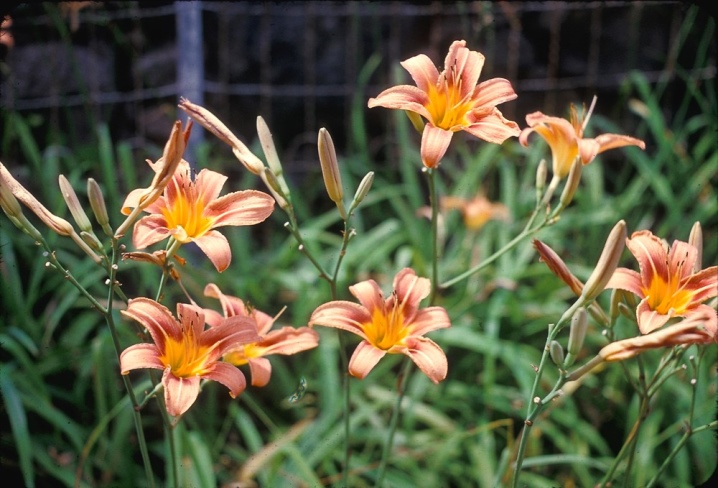
The size of flowers in hybrid daylilies can be 0.07-0.2 m. Curiously, the size of the floral part of the plant is in no way related to the size of its other parts. There are known hybrid daylilies with small flowers and large bushes, but there are also opposite examples, when gorgeous buds appear on a mini-bush. As for the colors, it is very diverse. Among 18 relatively pure daylily flowers, there was “no place” only for blue shades.
There are also mixed color options. Mixtures are formed due to the occurrence of spots and stripes of a different tone. Hybrid daylilies are propagated mainly by dividing the bushes. This procedure is possible at any time if the plant is not blooming. But the best result will be at the end of summer.

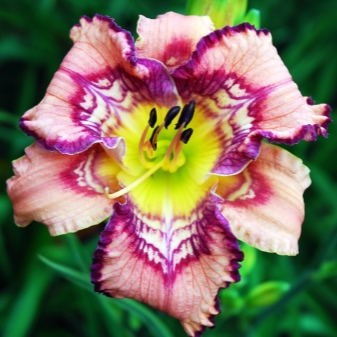
The species of daylilies that bloom all summer deserve a separate discussion - and there are not so few of them. First of all, we are talking about such varieties as:
"Dumortier";
"Orange";
Lemon Yellow;
"Brown-yellow".
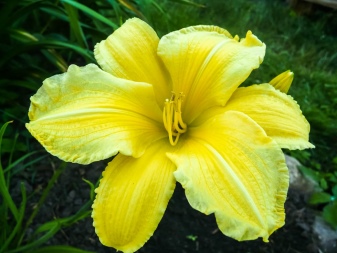

TET daylilies can bloom twice a season if the weather is warm in late summer and early September. The appearance of a new arrow occurs after "rest", which takes 14-20 days. There is a classification according to the size of flowers:
miniature group - up to 7.4 cm inclusive;
small - up to 11.5 cm;
large - more than 11.5 cm.
Description of the best varieties
Speaking about the ideal varieties of daylily, it is difficult not to remember such a name as Frans Hals... It was given in honor of the famous portrait painter, who was the first to capture such flowers. The plant is distinguished by tall (0.4-0.6 m), straight-standing arrows. The buds cover them abundantly. Flowering continues throughout the summer, and the buds reach 0.15 m in diameter.
After opening, the flowers amaze with rich colors and a sweet aroma. Almost always, the top is painted in a bright scarlet tone, and the core has a yellow tint. The variety is appreciated for its stable decorative qualities and for the reliability of the plant itself. You can save the basic characteristics if you use the division of the bush. Although the variety allows you to plant plants at any convenient moment of the growing season, rooting is optimal in early spring, when the frost will not return.

Frans Hals feels best in open, sun-drenched places. For its development, a loamy soil rich in organic matter is required. If severe cold comes in winter, the plant should be covered.The culture is compatible in appearance with almost any plant. At the same time, it is required to clearly set the task: either to focus on it, or to create a holistic ensemble in which other flowers are not overshadowed.


A good alternative could be "Catherine Woodbury"... The flowers of this hybrid herbaceous daylily are lavender-colored. Planting in the sun is the norm - then it will bloom in June and July. Important: the culture belongs to the remontant group. "Catherine Woodbury" is covered with leaves like swords and curving along its entire length.

The variety is good because it lives in one place for several years. Typical placement of petals is in two tiers, 3 pieces per tier. Very good combinations "Catherine Woodbury" form with other perennials that do not even give flowers.
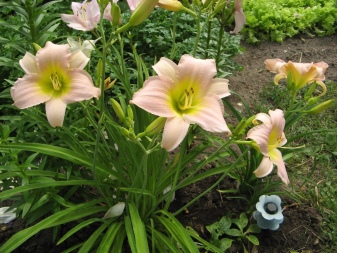

No less attention from gardeners and gardeners deserves "Bonanza"... This is a beautiful and, moreover, unpretentious plant to care for. It is characterized by the development of powerful fleshy roots. Wide linear foliage is 0.02-0.025 m long. The bushes are abundantly covered with foliage. In one place, a plant can live up to 15 years.
Bonanza is prized for its excellent resistance to cold weather and summer droughts.


The culture does not impose special requirements for the soil and for the care of the gardener. But the optimal appearance is achieved only under favorable growing conditions. On South "Bonanzu" should be planted in partial shade. In the northern regions of Russia, on the contrary, the daylily of this variety needs active lighting. A tight drainage is imperative, otherwise the roots will begin to rot.


Of the white daylilies, it deservedly stands out "Arctic snow"... It forms large flowers of an atypical shape, colored in an ivory tone. The height of the flower is up to 0.5-0.6 m, its diameter is 0.15 m. The bush is durable and keeps its shape stably.

Leaves "Arctic snow" dense and dark green in color. Peduncles are also quite strong and almost reach the leaves. Flowering occurs every year, moreover, abundantly. The first flowers bloom in early summer, and this process lasts almost until September.
The culture is equally good in single and group plantings.

"Arctic snow" looks great against the background of the lawn and coniferous perennial plants. In a mixed flower garden, the daylily of this variety is combined with:
reeds;
astrania;
iris;
phlox;
astilbe;
hosts and aquilegia.


Group boarding "Arctic snow" is used so that all colors (both dark and light) are represented equally.
The next variety that definitely falls into any ratings is "Double River Wi"... The duration of flowering of such daylilies is at least 25 days. Plant height can exceed 0.7 m. Terry flowers are relatively small, no more than 0.11 m in diameter, and have a lemon-yellow color.

In the descriptions, the greenish neck of the flowers must be noted. Plant "Double River Wi" preferably in an open, well-lit garden bed. Light shading is tolerated by plants calmly, but results in less abundant flowering. "Double River Way" is used both as tapeworms (near lawns, water bodies), and in groups together with perennials. The variety is suitable for cutting.

Deserves attention and "Pandoras boxing"... This daylily is an abundant flowering hybrid. The variety produces compact, graceful looking bushes. The flowers are creamy white with a purple-violet center and a greenish neck. The diameter of the flower reaches 0.08-0.09 m.

Flowering begins in the first half of July and lasts from 30 to 45 days. Important: each individual bud blooms for no more than 24 hours. But a quick change allows you to ignore it. The flower stalks are quite strong and rise above the bush. From 1 to 3 flowers develop on them at the same time; in the second bloom there are much fewer of them.

The leaves develop near the root, differ in brightness and juiciness. At the end of autumn, they die off. "Pandoras boxing" survives partial shade excellently, but it is much better to plant it in the sun. The variety is resistant to cold, but in a frosty winter, light shelter is still required. It is created from:
peat;
sawdust;
straw;
spruce branches;
crushed bark (optional).

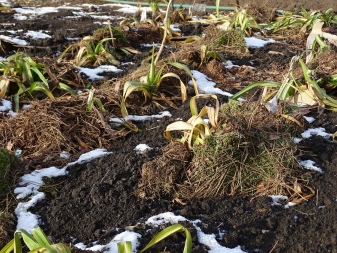
If drought occurs, the plant must be watered more actively. But many gardeners reasonably choose a completely different variety - Moses Fire... An adult daylily of this type grows up to 0.66 m. It will bloom in July and August. At the same time, double velvety flowers of a brick-red color with a light green neck appear.

Like many other daylilies, Moses Fire can bloom twice. The diameter of an individual flower reaches 0.15 m. The type of soil is not too important, a simple garden soil is enough. You can cope with insufficient soil fertility with compost or mineral mixtures. Shelter is only required during very harsh winters.
Moses Fire is wind-resistant and requires free space for its development.


Daylily "Night Embers" has a golden border and is terry to the touch. Mature plants reach 0.75 m. The diameter of the flowers is 0.13 m. "Night Embers" are valued for their increased resistance to cold and pleasing-looking corrugated petals. The color changes depending on the lighting: for sunny weather, a bronze-brown color is characteristic, and for cloudy weather, a dark crimson color.


Good happens and "Chicago Apaches"... This long-flowering hybrid daylily has a very high survival rate. He forms large flowers, collecting spreading inflorescences of 2-10 pieces. On adult daylilies "Chicago Apache" many flowers appear, and therefore the flowering period is significantly extended. The velvety of the corrugated petals painted in a rich red tone is noted.


Moreover, their middle has a bright light green color. The leaves of the "Chicago Apache" are not too wide and curved. Foliage decorativeness is preserved throughout the growing season. Flowers form on elongated peduncles.
Daylily of this variety does not require complex maintenance, and can be grown in any sufficiently drained land.

As for the variety Mildred Mitchell, then this perennial herbaceous culture grows to 0.66 m. The diameter of the flowers reaches 0.17 m. The plant will bloom in July and August. Resistance to winter cold corresponds to the 4th climatic zone. The flowers are painted in a pink-lavender tone, with a bluish eye and a border similar in color.

The inner petals of Mildred Mitchell daylilies are corrugated. The flowers give off a fragrant aroma. The evergreen is a tetraploid plant. Flowers are grouped on peduncles. Each inflorescence can include 1-3 flowers.


"Moonlight masquerade" blooms very beautifully and grows to 0.6-0.75 m. Wide leaves have a solid edge. Their curvature or straight structure is characteristic. The foliage of Moonlight Masquerade is tinted green. The flowers are large, funnel-like, with a diameter of 0.08-0.14 m.


The attractiveness of the flowers is due to their very graceful light cream color. In this case, the middle is painted in a dark purple tone. Blooms "Moonlight masquerade" from May to August. Like other daylilies, this variety can grow in partially shaded areas, but flowering there is less active. The plant thrives on fertile and well-moistened soil.
Its positive features are:
attractive fragrant aroma;
minimal whimsical care;
high resistance to harmful insects and infectious diseases;
no need for frequent transplants;
increased winter hardiness;
suitability for both single and group disembarkation.


Daylily "Crimson pirate" belongs to the group of diploid plants. It has an average flowering period. The diameter of the flowers ranges from 0.12 to 0.14 m. Important: The Crimson Pirate requires at least 6 hours of insolation per day. For 1 sq. m. you can plant 4-9 pieces of daylilies.


"Lacey Dolly" - hybrid terry variety 0.5 m high. The plant is colored pink. It is customary to refer to it as a mid-layer group. Pink flowers "Lacey Dolly" are suitable for cutting. This plant shows the best flowering when planted in sunny places.

Users note the sweet scent of perennial daylilies "Lacey Dolly"... They bloom in July, August and September. The variety stands out for its very expressive multicolor, while it is bright and compact. Daylily petals are colored like “strawberries and cream”. On top there are also touches of yellow, peach, coral, purple and white.
The low height makes it easy to fit the Lacey Dolly into container landings. The smell is pleasant, but unobtrusive. Transplantation and division of the plant occurs every few years.

Not a bad choice can be "Sabine Bauer"... Mature shrubs of this variety reach 0.6 m. Flowering occurs from June to August. Flowers reach 0.15 m in diameter. The petals have a beautiful creamy coffee color, diluted with a black and burgundy spot. The corrugated border is painted in the same way. Winter hardiness of "Sabine Bauer" corresponds to the 4th climatic zone.


Solid competition to other perennials can be Longfields Pearl... The height of this daylily is 0.5 m, and it is painted white. A medium-sized plant develops well in the sun. It can bloom in July and August. Longfields Pearl flowers smell light and pleasant. Even when flowering ends, the shrub retains its decorative effect.

Deserves attention and "Night bacon"... This hybrid daylily is 0.6 m high and forms very dense bushes. The plant is characterized by straight peduncles. For planting, medium loam with good drainage is recommended.
Watering "Night Bacon" is necessary only during dry periods.


"Sorry mi" - another hybrid daylily. The plant belongs to the diploid type, has a height of 0.45-0.5 m. The diameter of the flowers does not exceed 0.07 m. The bright red flowers are very fragrant. It can grow in one place up to 10 years, although it is usually limited to 5-6 years.
For 1 sq. m. there can be from 4 to 9 bushes. You can use the variety in:
flower groups;
tapeworms;
mixborders;
the design of the banks of reservoirs.


Daylily "Double Dream" blooms from June to August. Growing in the sun and in partial shade is allowed. Re-flowering is possible. The diameter of the flowers is 0.1-0.11 m. A positive feature of the plant is its high winter hardiness. Like many people and Divas Choice... This variety is one of the semi-evergreen tetraploids with repeated active flowering. At the "Divan Choice" flowers form 0.2 m in size. The height of the plant itself is up to 1 m. The variety appeared quite recently, but its color has already managed to charm tens of thousands of people.

As for the variety Mauna Loathen it is a hybrid daylily introduced back in the mid-1970s. In sleeping tetraploids "Mauna Loa" bushes up to 0.56 m high are formed. Flowers reach 0.125 m in diameter. They are painted in amber-gold tone and have an expressive red edge. The light green neck looks good too. Important: Mauna Loa is only suitable for the 3rd climatic zone maximum.

And here "Cherry Chicks" - a hybrid, characterized by a very unusual coral-crimson color. The plant fits perfectly into any garden and park landscapes. It is combined with:
millennials;
decorative cereals;
dotted loosestrife;
lyatrix.

"Blizzard Bay" has a white or yellow color. The height of the daylily itself reaches 0.6 m. At the same time, the diameter of the flowers can be 0.15 m. The culture perfectly tolerates the most severe cold weather. Basically "Blizzard Bay" is planted in mixborders and near water bodies.
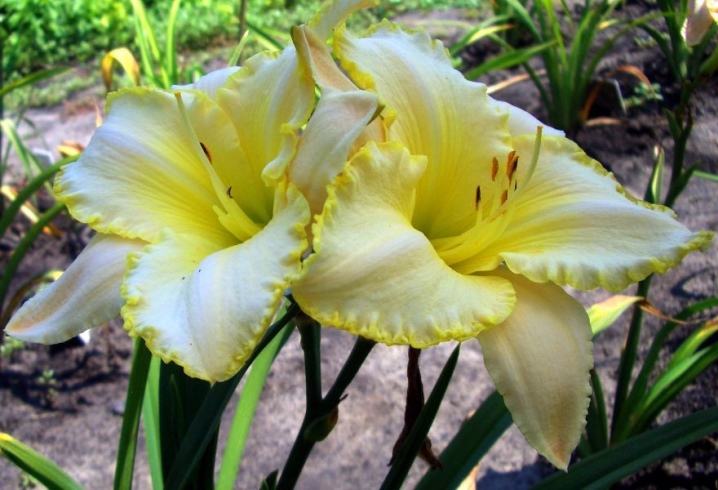
"Blizzard Bay" is deservedly included in the list of the best spring hybrids. And here "Strawberry Candy" it has a strawberry pink color.A pink-red eyelet and a similar border on the corrugated petals inside add romance. The highest plant height is 0.65 m, while the diameter of the flowers is 0.11 m.

"Strawberry Candy" actively used for a garden of stones. But it can be lovely "Destind to Si"... This plant is planted according to the scheme 0.6-0.7 m. The size of flowers can reach 0.15 m. Tetraploids retain their green color all year round, their height reaches 1 m.


From the light yellow neck of the daylilies series "Destind" a pleasant aroma comes out. The maximum winter temperature is 40 degrees. A "David Kirghof" has petals of raspberry pink and lavender flowers. The height of the plant reaches 0.7 m with a flower diameter of 0.14 m. The saturation of the colors, surprisingly, strongly depends on the current weather.


Stella de Oro it is compact (maximum 0.4 m). Juicy yellow flowers are also small - up to 0.055 m in diameter maximum. These properties, together with rapid growth, make "Stella" an excellent candidate for a flower bed, lawn and miniature flower garden. But for reliability they praise "Elegant Candy" - This daylily produces pink flowers with a red-pink "rim" above the green-yellow throat. The narrow, curved leaves will remain graceful for the rest of the growing season.


How to choose?
The relevance of the correct choice is due to the fact that more than 52,000 different daylilies are already known. The final decision can be made after drawing up an accurate planting scheme, which will take into account the placement of both large trees and bushes, and small architectural forms. Important: contrary to popular belief, evergreen daylilies suffer not so much from frost as from long thaws, followed by regular cold weather. Therefore, you will have to choose between the stability of old varieties and the risks that arise when breeding plants that have been bred only recently.
The so-called night daylilies are popular, which create a stunning impression in the electric light.

"Long-flowering" varieties are recognized as remontant in catalogs and lists; almost all of them are tetraploids. Important: for the domestic climate, it is necessary to choose varieties that produce a pair of peduncles with a short period of time. Then flowering will last until the onset of the cold season. Also, the Russian specificity requires the use of daylilies with high branching. But when choosing them, you will have to pay maximum attention to a balanced type of plant.
For information on what types of daylily are and how to care for them, see the next video.




































































































The comment was sent successfully.